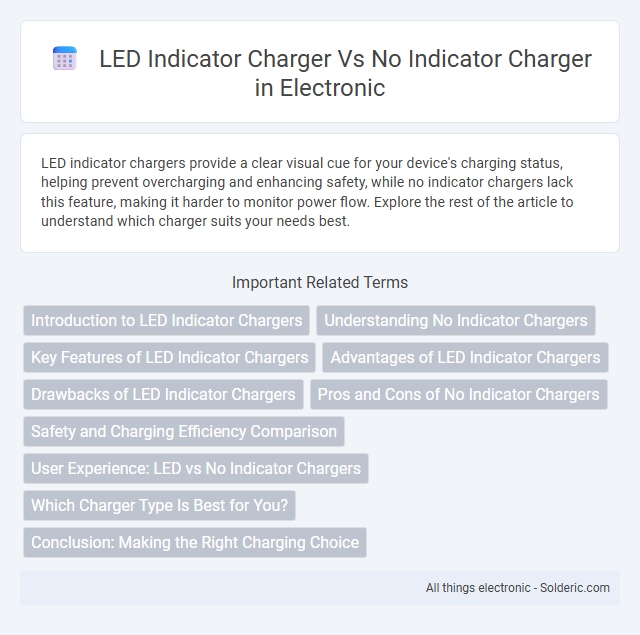LED indicator chargers provide a clear visual cue for your device's charging status, helping prevent overcharging and enhancing safety, while no indicator chargers lack this feature, making it harder to monitor power flow. Explore the rest of the article to understand which charger suits your needs best.
Comparison Table
| Feature | LED Indicator Charger | No Indicator Charger |
|---|---|---|
| Charging Status | Shows real-time charging progress via LED light | No visual indication of charging status |
| User Convenience | Easy to know when device is fully charged | Requires manual checking of device battery |
| Power Consumption | Minimal additional power used by LED | No extra power usage |
| Cost | Generally higher price due to extra components | Lower cost and simpler design |
| Durability | LED may fail over time, slightly reducing longevity | Fewer components; potentially longer operational life |
| Safety | Helps prevent overcharging by signaling completion | Greater risk of overcharging without indicator |
Introduction to LED Indicator Chargers
LED indicator chargers feature a built-in light that signals charging status, enhancing user convenience by providing real-time feedback. These chargers help prevent overcharging and potential battery damage by clearly displaying when the device is fully charged. In comparison, no indicator chargers lack this visual feedback, making it harder to monitor charging progress and battery health.
Understanding No Indicator Chargers
No indicator chargers lack visual cues such as LED lights, making it difficult to confirm charging status or detect connectivity issues. This absence can lead to overcharging, device damage, or user inconvenience due to uncertainty about power flow. Understanding no indicator chargers helps consumers weigh the trade-offs between simplicity, cost savings, and the need for real-time feedback during charging.
Key Features of LED Indicator Chargers
LED indicator chargers provide real-time visual feedback on charging status, enhancing user convenience and safety by displaying whether a device is fully charged, charging, or if there's an error. These chargers often feature energy-efficient, bright LEDs that help prevent overcharging and extend battery life by signaling when to unplug the device. In contrast, chargers without indicators lack this immediate status display, potentially increasing the risk of battery damage and inefficient power use.
Advantages of LED Indicator Chargers
LED indicator chargers provide real-time visual feedback on charging status, helping you easily identify when your device is fully charged or still powering up. This feature reduces the risk of overcharging, thereby extending battery life and improving overall device safety. The clear LED signals enhance user convenience by eliminating guesswork during the charging process.
Drawbacks of LED Indicator Chargers
LED indicator chargers often consume additional power due to the constant illumination of the LED, which can reduce overall charging efficiency. The presence of the LED indicator may also increase the risk of overheating, potentially shortening the lifespan of both the charger and the device battery. Furthermore, LED lights may cause distractions or discomfort in low-light environments, limiting their usability during nighttime charging.
Pros and Cons of No Indicator Chargers
No indicator chargers offer a minimalist design that reduces manufacturing costs and potential points of failure, making them often more affordable and durable. However, the lack of an LED indicator means users cannot visually confirm charging status or completion, potentially leading to overcharging or uncertainty about device connectivity. This absence of feedback can hinder user convenience and may increase the risk of battery damage from prolonged charging or improper connection.
Safety and Charging Efficiency Comparison
LED indicator chargers enhance safety by providing real-time visual feedback on the charging status, reducing the risk of overcharging or overheating. Chargers without indicators lack this immediate monitoring feature, which can lead to unnoticed faults or inefficient charging cycles. The presence of an LED indicator contributes to optimized charging efficiency by signaling when the device is fully charged, thereby preventing energy waste and extending battery lifespan.
User Experience: LED vs No Indicator Chargers
LED indicator chargers enhance user experience by providing real-time status updates, such as charging progress and completion, eliminating guesswork. No indicator chargers leave users uncertain about the charging status, often leading to overcharging or premature unplugging. Your convenience improves significantly with LED indicators, ensuring efficient and timely device management.
Which Charger Type Is Best for You?
Choosing between an LED indicator charger and a no-indicator charger depends on your need for real-time charging status visibility; LED indicators provide immediate feedback, making it easier to monitor charging progress and prevent overcharging. Chargers without indicators appeal with simpler design and lower cost but require you to check devices manually to avoid potential battery damage. Your best option balances convenience, safety, and budget, so an LED indicator charger is ideal if you prioritize efficient monitoring of your device's power levels.
Conclusion: Making the Right Charging Choice
Choosing an LED indicator charger offers clear benefits by providing real-time charging status, preventing overcharging, and enhancing device safety through visual feedback. Chargers without indicators lack these features, increasing the risk of leaving devices plugged in unnecessarily or experiencing battery wear due to prolonged charging. Prioritizing an LED indicator charger ensures efficient charging management and extends your device's battery lifespan.
LED indicator charger vs No indicator charger Infographic

 solderic.com
solderic.com